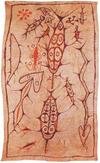- bark painting
-
Abstract and figurative designs applied to nonwoven fabric made from bark.Also called tapa, the pieces are made by scratching or painting the designs. The most popular material is the inner bark of the paper mulberry tree. The bark is stripped off, soaked, and beaten until it is thin. Today hand-painted bark cloth is made in northern Australia, New Guinea, and parts of Melanesia. Styles and imagery vary by location, from naturalistic and stylized representations of human and animal forms to mythical beings, spirals, circles, and abstract motifs.
 Tapa wall drapery painted with animal clan emblems, from the Teluk Jos Sudarso (Humboldt Bay) area, ...Holle Bildarchiv, Baden-Baden, Ger.
Tapa wall drapery painted with animal clan emblems, from the Teluk Jos Sudarso (Humboldt Bay) area, ...Holle Bildarchiv, Baden-Baden, Ger.* * *
▪ artalso called Tapa, or Bark Cloth,nonwoven fabric decorated with figurative and abstract designs usually applied by scratching or by painting. The basic clothlike material, produced from the inner bark, or bast, of certain trees (see bast fibre), is made by stripping off the bast, soaking it, and beating it to make the fibres interlace and to reduce thickness. The most popular material is the inner bark of the paper mulberry tree, although breadfruit and fig trees are also used. Hand-painted bark cloth is limited today primarily to northern Australia, the island of New Guinea, and parts of Melanesia.On the Australian mainland, style varies according to location: from the Kimberley region to Oenpelli in the west, a naturalistic rendering of human and animal forms prevails; in the east, a schematized style, relying heavily on the lozenge motif, dominates; between Oenpelli and Groote Eylandt in the Gulf of Carpentaria, the schematized and naturalistic styles coexist. In the Kimberley region, bark paintings frequently depict mythological beings known as Wondjinas; it is not known whether the bark wandjina (wandjina style) images had a religious significance, as did those that appear on the walls of caves. In Arnhem Land, where the X-ray style—which shows the internal structures of animals—is concentrated, bark paintings are done in a style of schematic naturalism. Some bark paintings, usually those depicting the Ancestors, can be viewed only by initiates. Others, which contain mostly narrative subject matter, may be viewed by all.In New Guinea, animal motifs are predominant in the Lake Sentani–Humboldt Bay area; but in the art of the Gulf of Papua, where animal images are conspicuously absent, abstract motifs, such as the spiral and circle, and highly stylized representations of the human figure prevail. Bark painting rarely appears in the art of the Sepik River basin, and no examples have been found in the Asmat or Massim regions. In Melanesia the style and content of bark paintings varies from region to region. See also wandjina style.* * *
Universalium. 2010.
